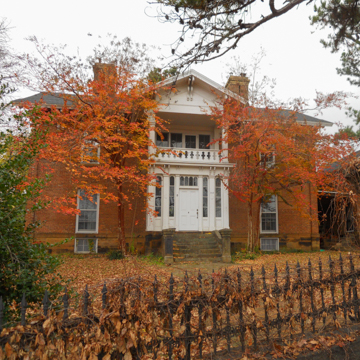Born in Alabama in 1825, Gregg moved with his parents to a farm north of present-day Fayetteville in 1837. He became a lawyer, served in the Union Army during the Civil War, and was also a state representative, among other activities. This two-story double-pile Italianate house built for him and his wife, Mary Shrave, occupies a large lot. The house is constructed of red brick and locally quarried brown sandstone, and the entrance steps are of sandstone. A wooden two-story gabled entrance portico in front of the central bay features a balustraded balcony at the second floor, and pairs of wooden brackets support the portico’s gable and the deep roof overhang. The two-story wooden verandah on the house’s rear has been partially enclosed. The house has a central hall, and a chimney is set between each pair of rooms. An icehouse of red brick is adjacent to the north side of the house, and a two-story kitchen and smokehouse stand near the rear.
You are here
Lafayette and Mary Gregg House
If SAH Archipedia has been useful to you, please consider supporting it.
SAH Archipedia tells the story of the United States through its buildings, landscapes, and cities. This freely available resource empowers the public with authoritative knowledge that deepens their understanding and appreciation of the built environment. But the Society of Architectural Historians, which created SAH Archipedia with University of Virginia Press, needs your support to maintain the high-caliber research, writing, photography, cartography, editing, design, and programming that make SAH Archipedia a trusted online resource available to all who value the history of place, heritage tourism, and learning.





















